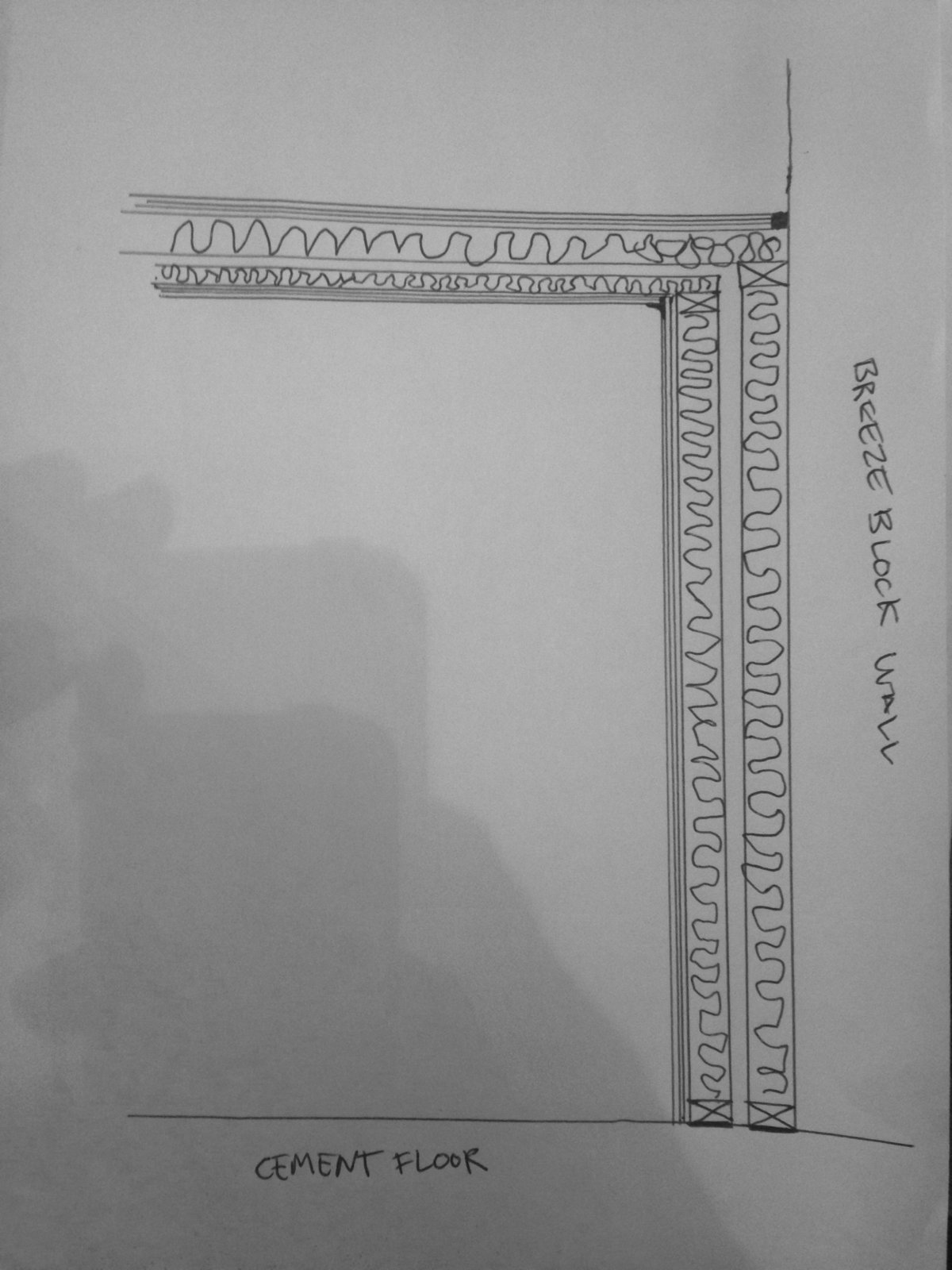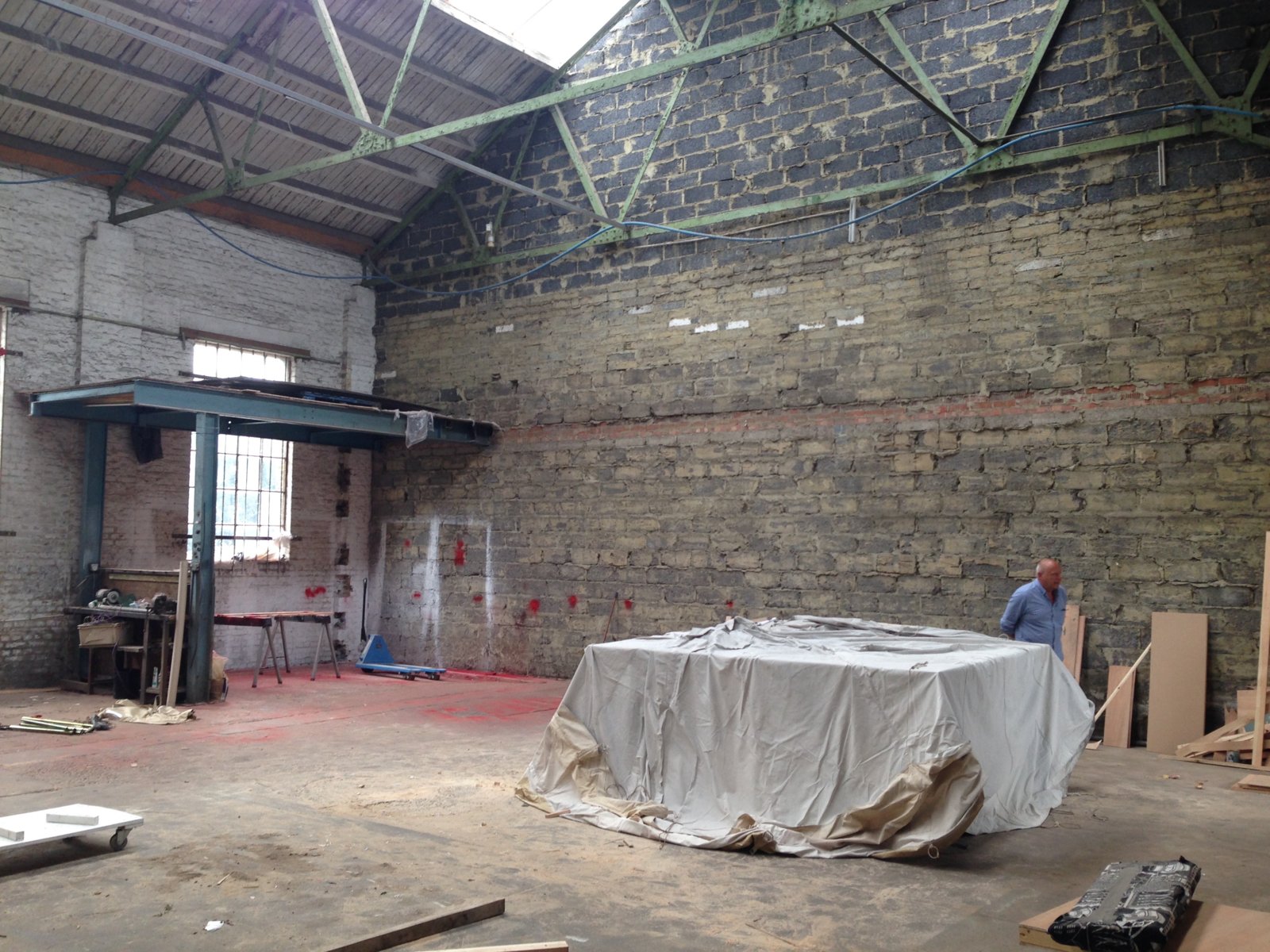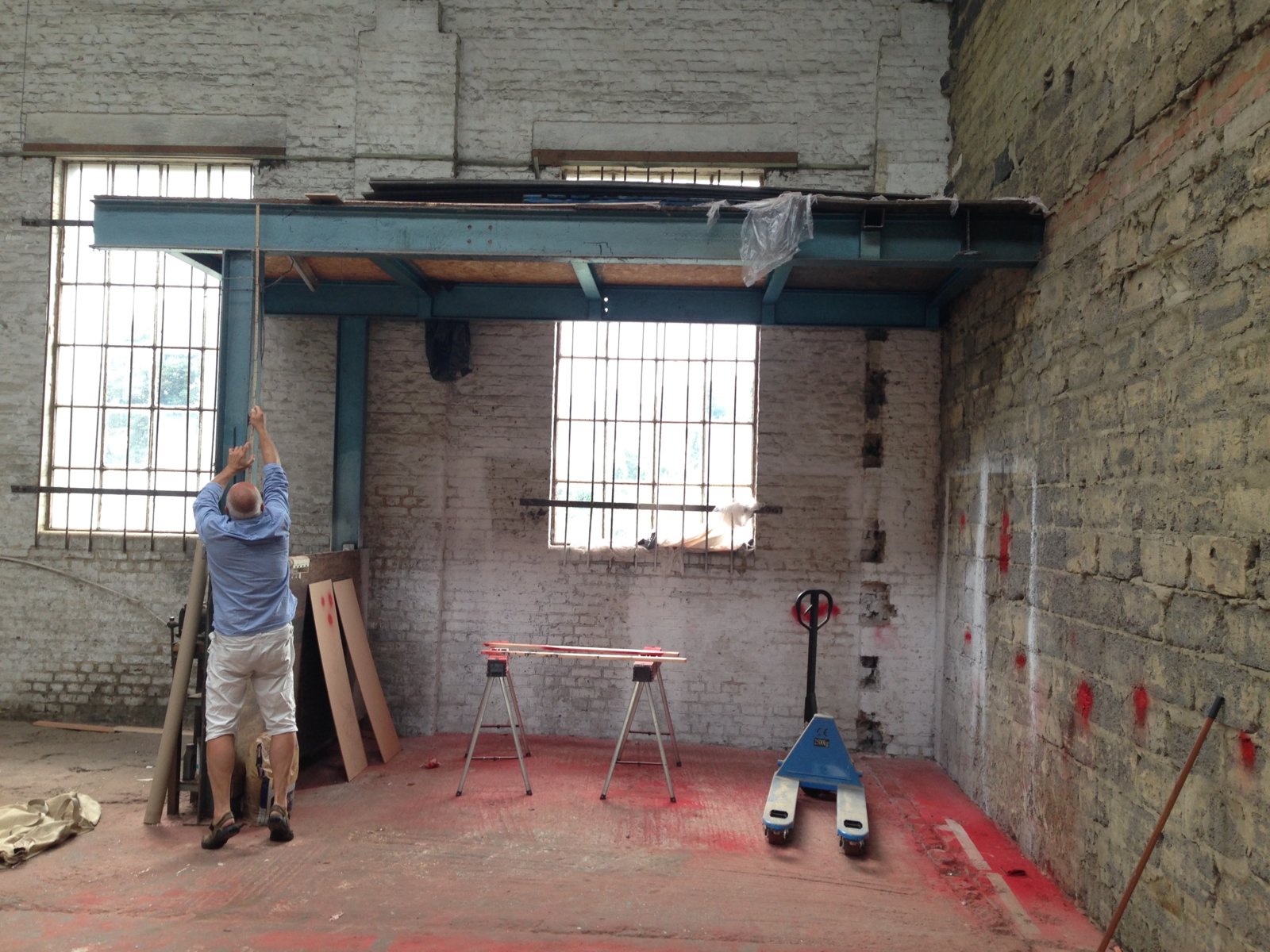hello recording.org, I'm new here, having read the rules i hope i won't break them,’ve searched the forums for the questions and haven’t been able to find them.
I'm about to start building a studio in Margate, UK. I've spent the last few months reading books, watching tutorials etc. Rod Gervais book brought me here and I've been reading a lot on this forum but still find i have a few questions.
The studio will be built in a large open warehouse with thick concrete floor and brick walls. (images attatched - the steel structure is being taken out in next couple of weeks) The size of my studio (inside measurements) will be (all in mm sorry) H - 2730 W - 4100 L - 9000 . This post will not really adress acoustic treatment, more the building of the actual box. There will be no live room / control room. I prefere to work in an open space with artists so Im basically just building 1 medium sized room. Budget is about £20 000
I'm building a double wall construction with 3 layers of plaster board inside and outside, trying to achive STC 69. There will be one large window (2 layers of laminted glass, STC 35 each), and here comes one of my first questions. Can you add 35db + 35db and it equals 70db? probably the most stupid question ever but want to double check. Same for the doors, am i ok with 2 x STC 35 doors (=70dB) to accomplish the total STC 69 of whole structure?
In Rod's book (second edition) on page 270 (Figure 10.16 - image attatched) he talks about a decoupled floor which doesn't involve floating a concrete slab. Im really curious about this cause it would save money and time.
There is another studio being built inside the warehouse, that guy is building his studio on a floating concrete slab. Im hoping to avoid it. there isn't really any outside low frequency sound in the warehouse apart from what both studios will be making. and the fact that the other guy is putting down decoupled concrete slab, i get the impression i might get away with not having to do it. (the other studio will start 50cm from my outer wall and being built in a very professional way) BUT there are also some things in Figure 10.16 that confuse me.
- inside the 2 layers of plaster board there seem to be a thin layer of insulation (not specified) which sits ontop of floor, then another layer of somethign that looks like plaster board (but if the drawings are to scale it looks slightly thicker), has anyone else built this type of floor and can advice?
- Rod suggest a layer of rigid fibreglass insulation (3 pcf), i've seen other similar decoupled floor where they use 1 layer of 12.5mm soundboard (celotex), then 25mm mineral fibre (33kg/m3) and then another layer of Celotex. The celotex confuse me cause its a really light material, but much more expensive than thick floor sheets of styrofoam. The styrofoam is obviously much cheaper than a 3pcf insulation but nowhere near as dense, I'm just curious if anyone has worked with styrofoam layered under plywood (again refering to figure 10.16), i assume the bass frequencies would just pass through it and into concrete floor, hence why Rod recomends a 3 pcf insulation?
Another thing we’re not 100% sure about is building against the 2 brick walls (window wall, and long breeze block wall) . the long breeze block wall has got cracks in it (next door is a car garage) so we will plaster that wall really carefully to make sure there are no holes. we’re then planning on using the brick wall as our ‘plasterboard layer’ on that side of studio (SEE ATTACHED DRAWING but dont mind scale, all walls and ceiling is same thickness and same air gap). Im very curious about what you all think of this idea, and also what you think of the sealing between roof top 3 layers of plasterboard against the plastered wall. we where thinking of stopping roof plasterboard a few cm from the wall (since wall is not perfectly straight), then filling void between wall and plaster with cement, then a final layer of thick caulk sealant to finish it off (how important is it using acoustic sealant? or is a good decorators caulk enough?)
Which brings me to another question about sealing, would you seal between layers of plaster boards on walls and ceiling? we'll stagger our seams but I'm still wondering if there should be acoustic sealant or decorators caulk in the small cracks before you add next layer of plaster board. and if so, how long would you wait to put next layer of plaster board on, since sealant dries by evaporating moisture. i assume we don't want any moisture like that trapped inside the walls?
and a last question for now. I’ve seen different density insulations for walls being recommended, some saying it doesn't matter, and some saying it should be pretty heavy (which make sense). can someone recommend a good insulation density for my build? th structure will be made up of 5x2 so theres plenty of space for thick heavy insulation if needed. Airgap between walls will be about 8cm we're thinking.
Im sure this will only raise more questions for us, but i’d be very grateful for any help.
thanks. Johan
Tags
Comments
hey Kyle, thanks soo much for taking the time to asnwer my quest
hey Kyle, thanks soo much for taking the time to asnwer my questions! I'm getting different advice from a few different forums and trying to work out what best to do, but i've realised from feedback from different sources i havn't done my maths properly so my next step is to do that and then come back with whatever questions might come up =)
johan
". Or to ease impact noise like people's feet stomping on the fl
". Or to ease impact noise like people's feet stomping on the floor"
Or a drummer...I think it would be wise to decouple the drummers position in the room.
Also...you need to consider the new room the other guy is building. 23 inch or 50 cm is not a recommended distance. ..sealed or not. 36 inches would be a better start. You should talk to the other guy and find out his projected isolation target. If he goes for a tl....of 45 and you are shooting at 60....then his new room becomes your weakest link.
Brien, thank you for getting involved! =) im realising theres s
Brien, thank you for getting involved! =)
im realising theres still soo much i need to understand. my mian thread is here http://johnlsayers.com/phpBB2/viewtopic.php?f=2&t=20660
where you can see my mental progress over the last few days.
agree and understand we should have more space but there are limitations... more explained in other thread if you want to read it. i totally understand if you dont feel like reading through all that though =)
love. johan
a quick reply to both these comments though. the cement floor is
a quick reply to both these comments though. the cement floor is really thick as i said. i would be shocked if a drummers banging or any feet would trnasfere sound outside studio. but a really loud sub bass????
and the other guy is building a high end pro studio. i thought he was aiming for 45db per leaf (MSM structure) but ive just been told thats unlikley and its probably a toal of 45db.. which sounds really low to me so im really confused. ill get back with more info as soon as i know.. =)
Johan, Stuart, the mod involved in your build at johnlsayers.c
Johan,
Stuart, the mod involved in your build at johnlsayers.com is one of the brightest and fastest developers of these types of complicated builds you are going to find on line.
He and I have been doing this online for about a decade. .I am a Mod there as well.
(edit: I am not a mod here any longer)
So your best advice is going to come from over there...no one here can match what Stu can figure out mathematically...myself included.
Johan Hugo, post: 441136, member: 49976 wrote: i would be shocke
Johan Hugo, post: 441136, member: 49976 wrote: i would be shocked if a drummers banging or any feet would trnasfere sound outside studio. but a really loud sub
It is not going outside where the issue begins...it is because the sound will be generated inside the room creating acoustical issues you will have to deal with.
thank you brien! i cant tell how greatful i am to you, kyle and
thank you brien! i cant tell how greatful i am to you, kyle and obviously stuart for even taking the time to listen/read, let alone give long intricate answers. i don't know what i would do without it! i'll come back and post progress when i start building, hopefully someone else can learn from my current ignorance =)
Similar by terms
- AKG genuine CK12 Brass capsule: building DIY mic with a single Jfet-transistor
- Building a room within a room on a floating floor solutions
- Building a new recording studio, requesting advice.
- "Building 89" - somber blues instrumental
- New ROUND Table Series | Drum-Recording, Building Careers & Music Industry





Hi welcome to RO! Congrats on your studio, and reading Rods book
Hi welcome to RO! Congrats on your studio, and reading Rods book! It's an amazing price of literature. I've spent many years studying it and building studios using the methods it describes. Rod is very generous with his time as well!
To clarify your taking about two individual wall frames with drywall on the outer side of each wall correct? So plasterboard/wall frame -airspace- wall frame/plasterboard in that order.?
I'm not exactly sure on this but i belive that's how it works when talking about individual structural assemblies like walls and windows. Based on the diagrams in rods book a simple single wall is roughly stc 30 or so (sorry don't have it in front of me) and the double wall roughly doubled that in the upper 50s. It's the airspace and decoupling that contributes greatly to this effect. If those walls were touching each other they would be subject to the mass law.
When adding mass to something doubling mass adds 6db. So you double a single layer of plasterboard with a second and gain roughly 6db. To gain another 6db you need to add 2 more layers of plasterboard, equaling four total. To gain the next 6db you need to add an additional 4 layers, totaling 8. Ect Ect.
The goal reguardless is to make the doors and window panes match or exceed the mass of the wall it's mounted in. So if your walls are roughly 10lbs per square foot you'll want your window pane and door to equal that or exceed it.
There is no need to decouple the floor. The only practical reason to do so would be to run cables thru the floor. Or to ease impact noise like people's feet stomping on the floor. This isn't a concern since your on concrete and feet won't shake the concrete.
A thick concrete foundation (slab on grade) is an ideal floor to build your studio on. Simple smooth it/patch it if necessary and paint and stain it, or put whatever floor covering you choose directly on the concrete.
This is both ideal for isolation and most affordable.
The floor will not be the weak link between the two studios, the walls will.
The plans call for the use of plywood not plasterboard. It goes concrete floor, rigid fiberglass, 2 layers of plywood, floor covering.
Rod suggest what he does becuase he thinks it's best based on his knowledge. Usually his method is the most effective and cost effective for the particular application. Rigid mineral wool and foberglass are usually interchangeable, but styrofoams and other foams are not interchangeable with rigid fiberglass.
Stick to his plans as closely as possible. If it's not in the book it's becuase it doesn't work or becuase it's not cost effective, in general.
Are you saying your going to use the outer shell (existing brick wall) as the studio interior wall?
I'm unclear of what you mean by 'sealing between roof top and 3 layers of plasterboard against the plasterboard wall'
Could you explain this more?
Again I'm having a hard time picturing this junction point your talking about.
You want to use non hardening caulk only. (100%) Silicone and butyl caulking are acceptable and what you should use. Other types (like acrylic or acrilyc blends) will crack and fail over time.
Also, any caulk joint you do needs to be accompanied by foam backer rod. Otherwise it will eventually fail.
Get this stuff in a bulk roll on Amazon or whatever for cheap. It ensures a strong joint/seal and saves money by reducing the amount of caulking needed. Buying it at the home improvement store in the little bags will be expensive, order it bulk.
The sealing (backer Rod and caulk) needs to be done at the perimeter or the wall and ceiling sheathing only. In the middle (field) of the walls and ceilings you simply do a rough seem taking over the joint. This doesn't need to be finish coated/sanded. It's simply to cover the gap. Depending on how smooth it's applied you want need to quickly smooth some high/rough spots.
Standard unfaced 'fluffy' wall insulation is just fine. The insulation is simply there for thermal reasons, and to deaden any resonances within the double wall cavity.
Thick heavy insulation is a waste. Standard fluffy is fine.
If that translates to about 4" which the online calculator said, that's excellent! 1-4" is standard spacing between ISO wall frames.